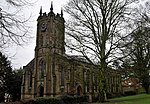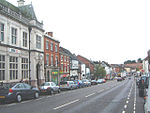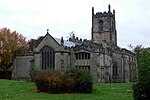Ashby de la Zouch railway station
Ashby-de-la-ZouchBeeching closures in EnglandDisused railway stations in LeicestershireFormer Midland Railway stationsGrade II* listed buildings in Leicestershire ... and 6 more
Grade II* listed railway stationsPages with no open date in Infobox stationProposed railway stations in EnglandRailway stations in Great Britain closed in 1964Railway stations in Great Britain opened in 1849Use British English from March 2015

Ashby de la Zouch railway station is a former railway station at Ashby de la Zouch in Leicestershire on the Leicester to Burton upon Trent Line. The Midland Railway opened it in 1849 and British Railways closed it in 1964. The station is a small Neoclassical building, with side pavilions and Doric columns in keeping with the nearby Royal Hotel of 1826. It is a Grade II* listed building.
Excerpt from the Wikipedia article Ashby de la Zouch railway station (License: CC BY-SA 3.0, Authors, Images).Ashby de la Zouch railway station
Royal Mews, North West Leicestershire
Geographical coordinates (GPS) Address Nearby Places Show on map
Geographical coordinates (GPS)
| Latitude | Longitude |
|---|---|
| N 52.7429 ° | E -1.4748 ° |
Address
Royal Mews
LE65 2GJ North West Leicestershire
England, United Kingdom
Open on Google Maps








